Abstract
Invar alloy possesses a uniquely low coefficient of thermal expansion, making it an ideal material for fine metal masks. To manufacture fine metal masks, Invar alloys are often cold-rolled, during which residual stress develops. Heat treatment is an effective means to control residual stress that develops within Invar sheets after cold rolling, but the treatment should be carried out with care. In this article, a comprehensive study on the effect of heat treatment on the residual stress, microstructure, and mechanical properties of a cold-rolled Invar sheet is reported. We show that while both recovery and recrystallization are effective means of reducing residual stress, substantial microstructural changes and, therefore, notable changes in mechanical properties and residual stress, occur after recrystallization. Moreover, residual stress release due to recrystallization can be affected by microstructure and texture prior to heat treatment as these factors play a significant role in recrystallization.
1. Introduction
Display unit manufacturers are heavily invested in developing high-resolution displays to promptly fulfill consumers’ demand for bigger television screens, smart device displays, and computer monitors. The resolution of these display units is primarily determined by RGB pixels. For organic light-emitting diodes (OLEDs), the pixels are arranged using an evaporation process. Fine metal masks (FMMs) play a pivotal role during the evaporation process by ensuring that each of the pixels is positioned precisely where it belongs. To successfully carry out their role, FMMs need to be well patterned and thermally stable [1]. Hence, Invar alloy, which is known to exhibit an exceptionally low coefficient of thermal expansion [2,3,4,5,6], is the ideal choice of material for FMMs. Because FMMs are typically a few tens of microns thick, Invar alloys for FMMs also need to be very thin. The target thickness of the alloys is typically produced by either cold rolling or electroplating [7,8]. Electroplating is advantageous in the production of thin-film Invar alloys [8,9]. However, cold rolling is still widely used because it is suitable for the mass production of metal sheets with high strength and homogeneous chemical composition.
Processes that impose plastic deformation on metals can result in the development of residual stress in the metals [10,11,12]. To manufacture quality FMMs using cold rolling, the residual stress in cold-rolled Invar sheets should be eliminated or carefully controlled. This is because chemical etching is very often involved in producing FMMs [7,13]. An etched thin metal sheet will deform if residual stress is present [14]. Therefore, the removal of residual stress after cold rolling is indispensable for high quality distortion-free FMMs.
The cold rolling and subsequent annealing of Invar alloys result in the recovery and recrystallization of the alloys. The rearrangement and annihilation of dislocations during recovery and grain nucleation and growth during recrystallization can drastically alter not only the mechanical properties of alloys, but also the residual stress [15,16,17]. It is known that the underlying factors that contributes to changes in the mechanical properties of a material can readily affect the residual stress of the material. In particular, heat treatment based metallurgical processes such as recovery and recrystallization can not only change the mechanical properties of an alloy, but also release residual stress in the alloy [16,17,18,19,20,21,22]. However, unwary heat treatment should be avoided because these processes, which are central to the alleviation of cold rolling induced residual stress in Invar sheets, can result in undesirable changes in the microstructures and mechanical properties of the sheets. For example, a fully recrystallized microstructure is undesirable for high-strength sheets, even though the microstructure can result in the complete release of residual stress. Thus, a comprehensive investigation into the evolution of the microstructure, the mechanical properties, and the residual stress of a cold-rolled Invar alloy upon heat treatment is fundamental to the development of Invar sheets with low residual stress and high mechanical properties. In this study, we explore how the microstructure, mechanical properties, and residual stress of a cold-rolled Invar sheet changes due to heat treatment of the cold rolled sheet.
2. Materials and Methods
2.1. Materials Perparation
Invar alloy with the chemical composition shown in Table 1 was used in this study. The as-received specimen with an initial thickness of 0.82 mm was cold-rolled to 0.381 mm. Annealing was carried out by placing the cold-rolled specimen in a tube type-furnace with a thermocouple in an Ar atmosphere at 400 °C, 500 °C, 700 °C, 800 °C, and 900 °C for 35 s. It should be noted that the specimens were not heated to the exact temperatures for 35 s because of the short annealing. However, the time was selected to reflect the annealing conditions used by Invar thin sheet manufacturing companies. The annealed specimens were aired-cooled to room temperature to observe and analyze the changes in the microstructure, mechanical properties, and residual stress of the cold-rolled sheet due to heat treatment.

Table 1.
Chemical composition of Invar alloy (wt%).
2.2. Mechanical Testing
Uniaxial tensile tests were performed on all the specimens using a servo-hydraulic universal testing machine to evaluate their mechanical properties. The tensile specimens conformed to ASTM E8 standard specimen-sheet type. The tensile tests were conducted at a strain rate of 0.001 s−1 at room temperature.
2.3. Microstructure Characterization
All the specimens submitted to microstructure characterization were prepared using mechanical grinding and micro-/colloidal-polishing methods. The microstructures of the specimens were characterized using the electron backscattering diffraction (EBSD) technique with a field emission scanning electron microscope (FE-SEM, JEOL-7900F, Jeol Ltd., Tokyo, Japan) with a step size of 0.66 microns for microstructure analysis. Multiple EBSD data scanned with a step size of 1.6 microns were used for the texture analysis. The EBSD analysis results were post-processed using TSL OIM 7 software.
2.4. Residual Stress Measurement
The residual stress measurements were performed on surfaces of cold-rolled and annealed specimens using X-ray diffraction (XRD, Xstress G3, stresstech). A CrKα radiation source with a collimator aperture of 5 mm in diameter was used. The measurements were performed in modified χ mode. The Fe austenite (311) reflection was measured in an angular tilt range from ψ = −40° to ψ = 40° with five steps. The exposure time was set above 15 s and a tilt oscillation of ±5° was imposed for each step. The acquired data were processed via Xtronic software to obtain residual stress values.
3. Results and Discussion
3.1. Effect of Heat Treatment on Microstructure Evolution
The microstructures of the specimens are shown in Figure 1, using inverse pole figure (IPF) maps. It can be observed that there are no notable changes in the IPF maps until 800 °C is reached. The microstructure of the cold-rolled specimen is characterized by elongated grain morphologies with high in-grain misorientation (Figure 1a). This characteristic microstructure is shared among all of the specimens annealed below 800 °C (Figure 1b–d), indicating that no recrystallization took place below 800 °C. Above 800 °C, clear indications of recrystallization, such as equiaxed grains with low in-grain misorientation and annealing twins, can be observed (Figure 1e–f). The recrystallization fraction at 800 °C is around 0.68, which means that recrystallization actually occurred between 700 °C to 800 °C. Complete recrystallization was observed at 900 °C (Figure 1f). The average grain sizes of the cold-rolled, partially recrystallized, and fully recrystallized specimens without ignoring annealing twins were 15.8 µm, 11.0 µm, 12.1 µm, respectively.
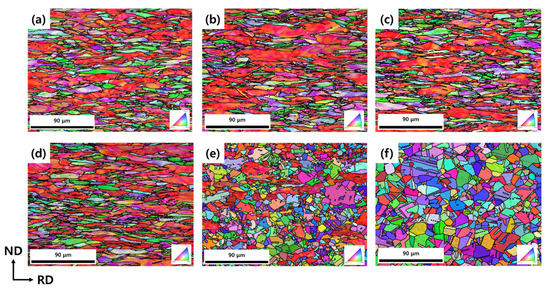
Figure 1.
Normal direction inverse pole figure (IPF) map of the (a) cold-rolled, (b) 400 °C, (c) 500 °C, (d) 700 °C, (e) 800 °C, and (f) 900 °C heat treated specimens.
The grain boundaries and low angle boundaries of the specimens are depicted in Figure 2. The densely populated low angle boundaries in the microstructure of the cold-rolled specimen suggest that the microstructure consisted of deformed grains. The abrupt change in the density of the low angle boundaries at 800 °C suggests that recrystallization occurred between 700 °C and 800 °C, which is in agreement with the conclusions drawn from Figure 1. By closely examining the microstructures of the non-recrystallized samples shown in Figure 2, it can be observed that the low angle boundaries are heterogeneously distributed. That is, some grains are heavily populated with low angle boundaries while others are not. The grains with relatively scarce low angle boundaries feature a {100} plane parallel to the normal direction (ND) of the specimen. It is known that dislocation density, which is correlated with low angle boundary density, is directly proportional to residual stress [17]. Hence, the presence of heterogeneously distributed low angle boundaries also means that residual stress within a microstructure is heterogeneously distributed, with {100}-oriented grains featuring lower residual stress values compared to grains with other orientations. In a study by Zhang et al. [23], an EBSD analysis of a cold-rolled AA1200 sheet revealed the grain size and orientation dependence of geometrically necessary dislocations (GNDs) in polycrystalline AA1200. The GND densities of {111} oriented grains were typically higher than those in {100}-oriented grains because grains with high Taylor factor are prone to rotation to activate slip systems, while grains with relatively low Taylor factor, or {100}-oriented grains, can activate necessary slip systems. This orientation-dependent dislocation content, which drives recrystallization, is a very important factor in controlling the recrystallization-induced relaxation of residual stress.
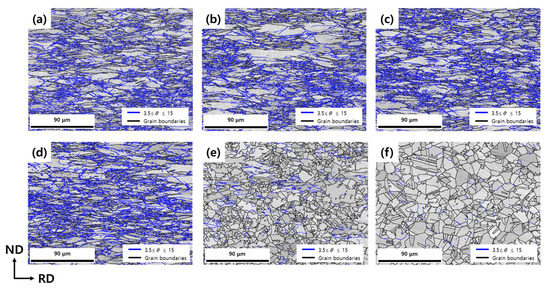
Figure 2.
Low angle boundary and grain boundary map of the (a) cold-rolled, (b) 400 °C, (c) 500 °C, (d) 700 °C, (e) 800 °C, and (f) 900 °C heat treated specimens.
Recrystallization is a process of nucleation and growth of stress-free grains. Recrystallization depends on stored deformation energy due to dislocation content. Regarding the fact that the dislocation density evolution of a grain highly depends on orientation of the grain, one can expect the evolution of the texture of a cold-rolled Invar sheet to have a significant impact on the recrystallization behavior of the sheet, which is directly correlated to the evolution of the residual stress, upon heat treatment. The textures of the cold-rolled and annealed specimens are presented in Figure 3 using orientation distribution function (ODF) plots. The cold-rolled specimen exhibits a strong Cube {001}<100> texture with Cu {112}<111>, Brass {011}<211>, and S {123}<634> as the subsidiary components. The specimen was likely to have been largely occupied by Cube-oriented grains prior to cold rolling given the fact that Cu, Brass, and S components are typical cold rolling texture components [24]. It has been reported that the stored deformation energy of a cold-rolled Fe-Ni alloy heavily depends on the GND density [25]. Therefore, by calculating the GND density of each grain, one can estimate whether a grain can recrystallize, or release residual stress, faster than other grains. From the EBSD data, the GND density can be estimated by the following equation:
where , , , , and , are parameter-related to grain boundary type, kernel average misorientation (KAM) angle, the nearest neighbor of the scan point in EBSD data, the scan step of the EBSD data, and the Burgers vector, respectively. In this study, the maximum misorientation was set to 5° and the second-nearest neighbor was used for KAM. The calculated average GND densities of the {001}-, {112}-, {011}-, and {123}-oriented grains within the cold-rolled specimen were 50.6 × 1012 m−2, 70.9 × 1012 m−2, 77.8 × 1012 m−2, and 70.0 × 1012 m−2, respectively. Given that the GND density is one of the major driving forces behind recrystallization, it is clear that the Cube-dominant Invar sheet represented in Figure 1 and Figure 2 will exhibit a slower residual stress release rate than other cold-rolled sheets with conventional cold rolling textures. The texture of the specimen remains unchanged until partial recrystallization occurs at 800 °C. At this point, the conventional cold rolling texture components are the first to be consumed by the recrystallized grains due to their high GND densities. The partial recrystallization clearly weakened both the cold rolling texture components and the Cube component (Figure 3e). Generally, the recrystallization of a cold-rolled, face-centered cubic material yields a strong Cube texture, which is an effective texture for the etching of FMMs [26]. In this case, because the deformation texture was already Cube-dominant, weakening of the Cube component was inevitable unless the recrystallized grains were mainly Cube-oriented. The texture of the recrystallized grains of the partially recrystallized specimen was mainly composed of a Cube with an intensity lower than that of the cold-rolled specimen, as shown in Figure 4. This was probably due to the low cold rolling reduction and initial Cube content prior to cold rolling. During recrystallization, recrystallized Cube-oriented grains grow into a Cube-dominant deformation matrix. Consequently, the moving grain boundaries during recrystallization are likely to be low angle grain boundaries. The mobility of the grain boundary is low for low-angle grain boundaries. This results in a reduced growth rate of recrystallization, and thus a reduced rate of residual stress. Finally, a relatively weaker Cube texture is formed upon complete recrystallization at 900 °C.
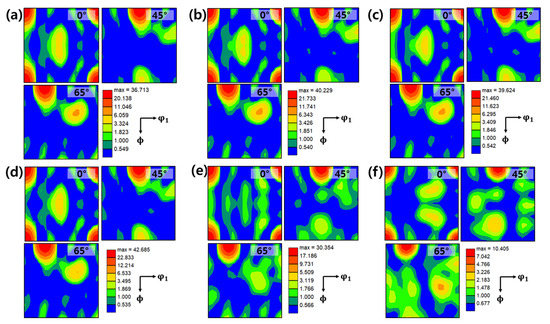
Figure 3.
Orientation distribution function plot of the (a) cold-rolled, (b) 400 °C, (c) 500 °C, (d) 700 °C, (e) 800 °C, and (f) 900 °C heat-treated specimens.
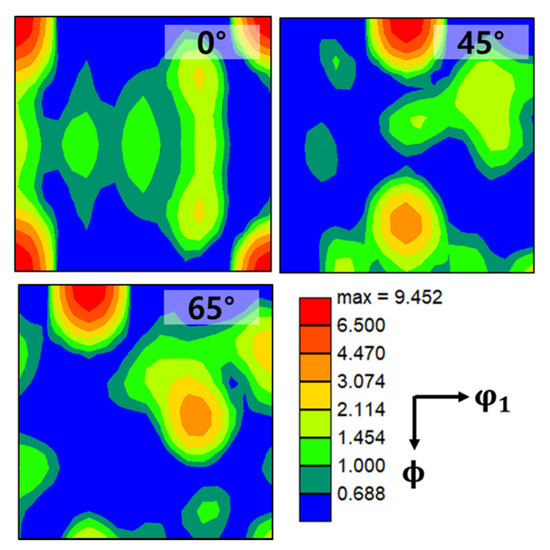
Figure 4.
Orientation distribution function plot of recrystallized grains of the specimen annealed at 800 °C.
3.2. Effect of Heat Treatment on Mechanical Properties
The stress strain curves of all the specimens are shown in Figure 5. It can be observed that the curves for the specimens annealed at 400 °C and 500 °C are comparable to the curve for the cold-rolled specimen. This indicates that a lack of recrystallization, as well as a negligible level of recovery, took place when annealed for 35 s under 500 °C. The lack of recrystallization is understandable, since the recrystallization temperature of Invar is typically above 650 °C, depending on the cold rolling reduction [18]. Furthermore, evidence of recovery in terms of hardness may occur above 600 °C for Invar alloys, depending on the cold rolling reduction [19], which explains why no notable indication for recovery in terms of tensile strength was observed for the specimen annealed at 500 °C. The specimen annealed at 700 °C experienced a small decrease in strength, accompanied by a moderate increase in ductility (Figure 5). Together with the lack of recrystallization observed in Figure 1 and Figure 2, this strength–ductility trade-off is a strong indication of recovery in which dislocation rearrangement and annihilation takes place. The specimen annealed at 800 °C was partially recrystallized. A substantial strength-ductility trade-off was observed and a significant level of strain hardening was recovered because the recrystallized fraction was as high as 0.68. The recrystallization process proceeds through the nucleation and growth of recrystallized grains that are stress-free and contain dislocation density that is significantly lower than that of the deformed grains. This is evidenced by the drastic decrease in the strength of the partially recrystallized specimen despite the fact that the recrystallized grains formed at 800 °C were generally smaller than the deformed grains (Figure 1). A further improvement in ductility with a decrease in yield strength took place upon complete recrystallization at 900 °C.
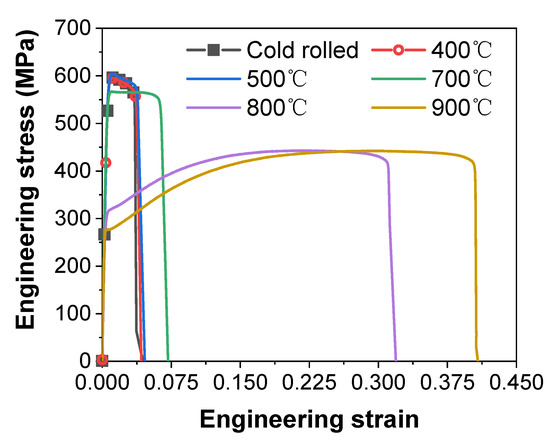
Figure 5.
Stress strain curves of the specimens.
3.3. Effect of Heat Treatment on Residual Stress
The residual stress of the specimens measured along the rolling direction (RD) and the transverse direction (TD) is shown in Figure 6a,b, respectively. It can be observed that tensile stress developed along the RD, while compressive stress developed along the TD. There was no notable decrease in residual stress for the specimens annealed at 400 °C and 500 °C; this was because neither recovery nor recrystallization took place. The recovery process resulted in the rearrangement and annihilation of dislocations in the specimen, and there was a very strong correlation between dislocation density and residual stress [17,20,21,22]. From [20,21,22], one can expect a rapid transformation of elastic strain, or the release of the residual stress, at early stages of recovery when dislocation density is still high. Similarly, the specimen annealed at 700 °C released 46% and 59% of the residual stress formed during cold rolling along the RD and the TD, respectively, due to recovery. Judging from the large reduction in the residual stress with recovery alone, one can successfully control the residual stress of a cold-rolled Invar sheet with a limited reduction in the strength of the sheet. The specimen experienced additional decrease in residual stress along both the RD and the TD at 800 °C, at which partial recrystallization took place. At this point, 73% of the residual stress formed during cold rolling along RD was released and the residual stress along the TD reached practically zero. The amount of residual stress released was slightly higher than the fraction of stress-free recrystallized grains. This suggests that the sizeable release of the residual stress can be attributed to both partial recrystallization and recovery. Partial recrystallization contributes to the release of residual stress by replacing deformed grains with stress-free grains, while non-recrystallized regions, which are mainly composed of deformed grains with a {100}-orientation, release residual stress through recovery. Additionally, the residual stress released within the non-recrystallized region by recovery at 800 °C is likely to be higher than the residual stress released at 700 °C because the average velocity of dislocation depends on temperature [22]. Essentially, all the residual stress is released upon full recrystallization at 900 °C.
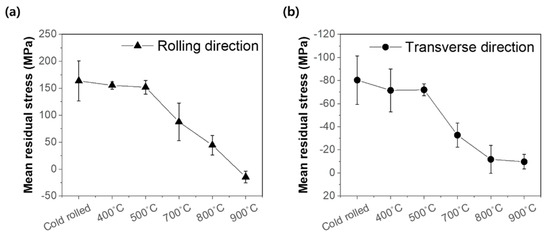
Figure 6.
Mean residual stress of the specimens measured along the (a) rolling direction and (b) transverse direction of the sheet.
The mechanisms behind the reduction in residual stress of the specimens are recovery and recrystallization. If the strength of the Invar sheet is less important than the residual stress in the sheet, recrystallization as the primary means of controlling residual stress is sufficient. In this case, a strong Cube texture prior to annealing can delay the residual stress release. On the other hand, if the strength of the Invar sheet is more important than the reduction in residual stress, recovery annealing, through which recrystallization is suppressed, may be desirable. In fact, recovery at higher temperatures can result in reduced residual stress [22]. In this case, a strong Cube texture prior to annealing can be advantageous given the low driving force for recrystallization of the texture.
4. Conclusions
In this study, we investigated the influence of heat treatment on the microstructure, mechanical properties, and residual stress of a cold-rolled Invar sheet. A cold-rolled Invar sheet was annealed at 400 °C, 500 °C, 700 °C, 800 °C, and 900 °C. The microstructure, mechanical properties, and residual stress of the cold-rolled and annealed Invar specimens were analyzed using the EBSD technique, a tensile test, and XRD-based measurements, respectively. The following conclusions were drawn from the analysis:
- Because {100}-oriented grains store fewer GNDs than grains with other orientations typically formed during cold rolling, cold-rolled specimens with high {100} contents can be less effective for residual stress release through recrystallization.
- To maintain a relatively high strength for the Invar used in this study, residual stress release through recovery at 700 °C is more desirable than release through recrystallization.
- A strong Cube content within a cold-rolled sheet reduces the driving force for recrystallization, which can result in higher recrystallization temperature.
Author Contributions
J.J., S.J.P. and J.G.K. conducted the microstructure characterization. S.J.P. and S.-H.J. conducted the experiments necessary for the mechanical analysis. J.K. and R.L. processed the Invar samples. J.J., Y.-S.O., S.-J.K., H.W.L., and S.-H.K. designed and supervised the research. S.J.P. and J.J. wrote the paper. All the authors analyzed and discussed the results. All the authors revised and approved the manuscript. All authors have read and agreed to the published version of the manuscript.
Funding
This study was supported by the Ministry of Trade, Industry and Energy supervised by the Korea Evaluation Institute of Industrial Technology (project No. 20011371) and the Korea Institute for Advancement of Technology (project No. N0002598).
Data Availability Statement
The data are available from the authors upon reasonable request.
Conflicts of Interest
The authors declare no conflict of interest.
References
- Choi, W.; Kim, H.Y.; Jeon, J.W.; Chang, W.S.; Cho, S.-H. Vibration-assisted femtosecond laser drilling with controllable taper angles for AMOLED fine metal mask fabrication. Materials 2017, 10, 212. [Google Scholar] [CrossRef]
- Hauschwitz, P.; Stoklasa, B.; Kuchařík, J.; Turčičová, H.; Písařík, M.; Brajer, J.; Rostohar, D.; Mocek, T.; Duda, M.; Lucianetti, A. Micromachining of Invar with 784 beams using 1.3 ps laser source at 515 nm. Materials 2020, 13, 2962. [Google Scholar] [CrossRef] [PubMed]
- Yang, Q.; Wei, K.; Yang, X.; Xie, H.; Qu, Z.; Fang, D. Microstructures and unique low thermal expansion of Invar 36 alloy fabricated by selective laser melting. Mater. Charact. 2020, 166, 110409. [Google Scholar] [CrossRef]
- Shin, S.; Hur, J.-G.; Park, J.K.; Kim, D.-H. Thermal damage free material processing using femtosecond laser pulses for fabricating fine metal masks: Influences of laser fluence and pulse repetition rate on processing quality. Opt. Laser Technol. 2021, 134, 106618. [Google Scholar] [CrossRef]
- Chun, K.; Jin, D.; Kim, S.; Lee, E. Comparison between wire mesh and plate electrodes during wide-pattern machining on invar fine sheet using through-mask electrochemical micromachining. J. Mech. Sci. 2017, 31, 1851–1859. [Google Scholar] [CrossRef]
- Wei, K.; Yang, Q.; Ling, B.; Yang, X.; Xie, H.; Qu, Z.; Fang, D. Mechanical properties of Invar 36 alloy additively manufactured by selective laser melting. Mater. Sci. Eng. A 2020, 772, 138799. [Google Scholar] [CrossRef]
- Kim, C.; Kim, K.; Kwon, O.; Jung, J.; Park, J.K.; Kim, D.H.; Jung, K. Fine metal mask material and manufacturing process for high-resolution active-matrix organic light-emitting diode displays. J. Soc. Inf. Display 2020, 28, 668–679. [Google Scholar] [CrossRef]
- Park, Y.B.; Kim, I.G. The gain of low thermal expansivity via phase transition in electroformed invar. Coatings 2018, 8, 169. [Google Scholar] [CrossRef]
- Li, A.; Zhu, Z.; Liu, Y.; Hu, J. Ultrasound-assisted electrodeposition of Fe-Ni film for OLED mask. Mater. Res. Bull. 2020, 127, 110845. [Google Scholar] [CrossRef]
- Breidenstein, B.; Denkena, B.; Krödel, A.; Prasanthan, V.; Poll, G.; Pape, F.; Coors, T. Production-related surface and subsurface properties and fatigue life of hybrid roller bearing components. Metals 2020, 10, 1339. [Google Scholar] [CrossRef]
- Singh, G.; Kalita, B.; Vishnu Narayanan, K.I.; Arora, U.K.; Mahapatra, M.M.; Jayaganthan, R. Finite element analysis and experimental evaluation of residual stress of Zr-4 alloys processed through swaging. Metals 2020, 10, 1281. [Google Scholar] [CrossRef]
- Coors, T.; Mildebrath, M.; Büdenbender, C.; Saure, F.; Faqiri, M.Y.; Kahra, C.; Prasanthan, V.; Chugreeva, A.; Matthias, T.; Budde, L.; et al. Investigations on tailored forming of AISI 52100 as rolling bearing raceway. Metals 2020, 10, 1363. [Google Scholar] [CrossRef]
- Choi, W.-K.; Kim, S.-H.; Choi, S.-G.; Lee, E.-S. Quadrilateral micro-hole array machining on Invar thin film: Wet etching and electrochemical fusion machining. Materials 2018, 11, 160. [Google Scholar] [CrossRef] [PubMed]
- Hospers, F.; Vogelesang, L.B. Determination of residual stresses in aluminum-alloy sheet material. Exp. Mech. 1975, 15, 107–110. [Google Scholar] [CrossRef]
- Neves, F.O.; Oliviera, T.L.L.; Braga, D.U.; da Silva, A.S.C. Influence of heat treatment on residual stress in cold-forged parts. Adv. Mater. Sci. Eng. 2014, 2014, 658679. [Google Scholar] [CrossRef]
- Terner, M.; Lee, J.; Marchese, G.; Biamino, S.; Hong, H.-U. Electron backscattered diffraction to estimate residual stress levels of a superalloy produced by laser powder bed fusion and subsequent heat treatments. Materials 2020, 13, 4643. [Google Scholar] [CrossRef] [PubMed]
- Wawszczak, R.; Baczmański, A.; Marciszko, M.; Wróbel, M.; Czeppe, T.; Sztwiertnia, K.; Braham, C.; Berent, K. Evolution of microstructure and residual stress during annealing of austenitic and ferritic steels. Mater. Charact. 2016, 112, 238–251. [Google Scholar] [CrossRef]
- Nishiyama, S.; Honda, Y.; Sato, D.; Tanabe, H. Effects of cold rolling and annealing conditions on recrystallization and r-value in Invar alloy. Tetsu-Hagane 1995, 81, 1097–1102. [Google Scholar] [CrossRef][Green Version]
- Tashiro, Y.; Maruhashi, Y.; Sato, T. Influence of second phase particles on recrystallization in Fe-36Ni alloy. Tetsu-Hagane 2003, 89, 530–535. [Google Scholar] [CrossRef][Green Version]
- Lin, Y.-C.; Zhu, J.-S.; Chen, J.-Y.; Wang, J.-Q. Residual-stress relaxation mechanism and model description of 5052H32 Al alloy spun ellipsoidal heads during annealing treatment. Adv. Manuf. 2021, 26, 1–14. [Google Scholar] [CrossRef]
- Chao, Q.; Thomas, S.; Birbilis, N.; Cizek, P.; Hodgson, P.D.; Fabijanic, D. The effect of post-processing heat treatment on the microstructure, residual stress and mechanical properties of selective laser melted 316L stainless steel. Mater. Sci. Eng. A 2021, 821, 141611. [Google Scholar] [CrossRef]
- Bai, Q.; Feng, H.; Si, L.-K.; Ran, P.; Wang, Y.-Q. A novel stress relaxation modeling for predicting the change of residual stress during annealing heat treatment. Metall. Mater. Trans. A 2019, 50, 5750–5759. [Google Scholar] [CrossRef]
- Zhang, S.; Liu, W.; Wan, J.; Misra, R.D.K.; Wang, Q.; Wang, C. The grain size and orientation dependence of geometrically necessary dislocations in polycrystalline aluminum during monotonic deformation: Relationship to mechanical behavior. Mater. Sci. Eng. A 2020, 775, 138939. [Google Scholar] [CrossRef]
- Tewari, A.; Suwas, S.; Srivastava, D.; Samajdar, I.; Haldar, A. Stability of cube oriented grains during cold-rolling of highly cube-oriented polycrystalline Nickel. Mater. Sci. Forum 2011, 702–703, 402–405. [Google Scholar]
- Betanda, Y.A.; Helbert, A.-L.; Brisset, F.; Mathon, M.-H.; Waeckerlé, T.; Baudin, T. Measurement of stored energy in Fe–48%Ni alloys strongly cold-rolled using three approaches: Neutron diffraction, Dillamore and KAM approaches. Mater. Sci. Eng. A 2014, 614, 193–198. [Google Scholar] [CrossRef]
- Zaefferer, S.; Baudin, T.; Penelle, R. A study on the formation mechanisms of the cube recrystallization texture in cold rolled Fe–36%Ni alloys. Acta Mater. 2001, 49, 1105–1122. [Google Scholar] [CrossRef]
Publisher’s Note: MDPI stays neutral with regard to jurisdictional claims in published maps and institutional affiliations. |
© 2022 by the authors. Licensee MDPI, Basel, Switzerland. This article is an open access article distributed under the terms and conditions of the Creative Commons Attribution (CC BY) license (https://creativecommons.org/licenses/by/4.0/).